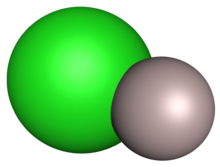
| |

| |
| Names | |
|---|---|
| IUPAC name
Chloridoaluminium[1]
| |
| Other names
Aluminium(I) chloride[citation needed]
| |
| Identifiers | |
3D model (JSmol)
|
|
| ChEBI | |
| ChemSpider | |
PubChem CID
|
|
CompTox Dashboard (EPA)
|
|
| |
| |
| Properties | |
| AlCl | |
| Molar mass | 62.43 g·mol−1 |
| Thermochemistry | |
Std molar
entropy (S⦵298) |
227.95 J K−1 mol−1 |
Std enthalpy of
formation (ΔfH⦵298) |
-51.46 kJ mol−1 |
| Related compounds | |
Related compounds
|
aluminium monofluoride gallium monofluoride |
Except where otherwise noted, data are given for materials in their standard state (at 25 °C [77 °F], 100 kPa).
| |
Aluminium monochloride, or chloridoaluminium is the metal halide with the formula AlCl. Aluminium monochloride as a molecule is thermodynamically stable at high temperature and low pressure only.[2] This compound is produced as a step in the Alcan process to smelt aluminium from an aluminium-rich alloy. When the alloy is placed in a reactor that is heated to 1,300 °C and mixed with aluminium trichloride, a gas of aluminium monochloride is produced.[3]
- 2 Al(alloy) + AlCl3(gas) → 3 AlCl(gas)
It then disproportionates into aluminium melt and aluminium trichloride upon cooling to 900 °C.
This molecule has been detected in the interstellar medium, where molecules are so dilute that intermolecular collisions are unimportant.[4]
See also[edit]
References[edit]
- ^ "chloridoaluminium (CHEBI:30131)". Chemical Entities of Biological Interest (ChEBI). UK: European Bioinformatics Institute.
- ^ Chase, M. W.; Curnutt, J. L.; Prophet, H.; McDonald, R. A.; Syverud, A. N. (1975-01-01). "JANAF thermochemical tables, 1975 supplement". Journal of Physical and Chemical Reference Data. 4 (1): 1–176. Bibcode:1975JPCRD...4....1C. doi:10.1063/1.555517. ISSN 0047-2689.
- ^ Totten, George E.; MacKenzie, D. Scott (2003). Handbook of Aluminum. CRC Press. ISBN 0-8247-0896-2.
- ^ J. Cernicharo, M. Guelin (1987). "Metals in IRC+10216 - Detection of NaCl, AlCl, and KCl, and tentative detection of AlF". Astronomy and Astrophysics. 183 (1): L10–L12. Bibcode:1987A&A...183L..10C.

Well, that’s interesting to know that Psilotum nudum are known as whisk ferns. Psilotum nudum is the commoner species of the two. While the P. flaccidum is a rare species and is found in the tropical islands. Both the species are usually epiphytic in habit and grow upon tree ferns. These species may also be terrestrial and grow in humus or in the crevices of the rocks.
View the detailed Guide of Psilotum nudum: Detailed Study Of Psilotum Nudum (Whisk Fern), Classification, Anatomy, Reproduction